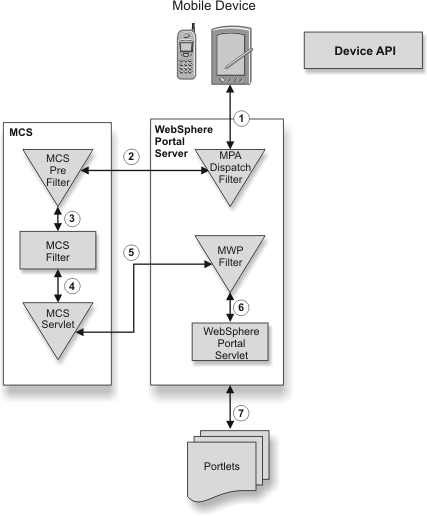This overview shows how data is passed from a customer's mobile device, through Mobile Portal Accelerator and the XDIME aggregator, and back to the customer's mobile device.
Multi-Channel Server runtime
WebSphere® Portal uses the Multi-Channel Server (MCS) runtime code to convert XDIME markup into a markup language that can be used by a requesting device. The illustration and the list that follows describe how the MCS runtime plugs into WebSphere Portal:Figure 1. MCS and
XDIME aggregator flow

The mobile device request flow is
as follows:
- The mobile device makes a page request, which is received by WebSphere Portal, is sent to the Mobile Portal Accelerator.
- The MPADispatchFilter dispatches the request to MCS (through a "forward" call).
- The MCSPreFilter prepares the request for MCS and forwards the request.
- The MCSFilter prepares the request for application (device identification, and so on) and forwards the request.
- The MCSServlet dispatches the request back to the WebSphere Portal server.
- The MWPFilter intercepts the request and prepares the request for Preload Notice (PLN) handling.
- The WebSphere Portal servlet aggregates the portlets to generate XDIME.
The return response flow is as follows:
- The Portlets generate XDIME, possibly using information from the mobile device to control output.
- The WebSphere Portal servlet aggregates portlet XDIME into the response and returns the response.
- The MWPFilter returns the response.
- The MCSServlet returns the response.
- The MCSFilter processes the XDIME and generates device specific markup in the response and returns the response.
- The MCSPreFilter returns the response.
- The MPADispatchFilter returns the response to the mobile device.